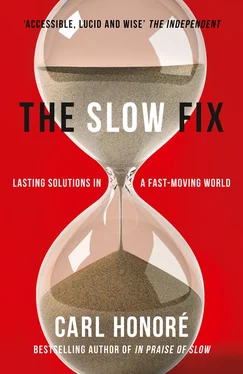If owning up to a mistake is seldom as bad as we fear, however, it is only the first step towards a Slow Fix. The next is taking the time to work out exactly how and why we erred in the first place.
CHAPTER THREE
THINK HARD: Reculer Pour Mieux Sauter
Don’t just do something, stand there.
White Rabbit in Alice in Wonderland (Disney version)
If asked to design an office that could make staff look forward to Monday morning, you might come up with something like the headquarters of Norsafe. Every window looks onto a snapshot of bucolic bliss. Clapboard houses nestle in the forest, small boats bob alongside wooden piers, gulls float across a clear sky. In the late morning, the sunshine turns this narrow waterway in southern Norway into a strip of shimmering silver.
For many years the company’s balance sheet looked similarly idyllic. Norsafe has been building boats since 1903 in a country where boating is a serious business. With more coastline than the United States, this long, slender nation on the northern edge of Europe has always looked to the sea. Even today, one in seven Norwegians owns some sort of watercraft. But looks can be deceiving. Not so long ago Norsafe was a firm on the verge of a nervous breakdown, where nobody looked forward to coming in to work on Monday morning.
The company manufactures highly specialised lifeboats for oil rigs and supertankers. Enclosed like a submarine, and painted a vivid, regulation orange, they can drop into the sea, with a full load of passengers, from a height of nearly 40 metres. In the mid-2000s, as the global economy boomed, orders flooded in from around the world, tripling Norsafe’s turnover. Yet behind the top line numbers, the firm, like Toyota, had lost control of its inner workings and was struggling to keep up. Deadlines slipped, design faults passed unnoticed through the production plant, customer complaints went unanswered. With lawsuits piling up and profits plunging, the design, manufacturing and sales teams were at each other’s throats. Everyone knew there was a problem, but no one knew how to fix it.
The turning point came in 2009, when an organisational consultant named Geir Berthelsen delivered a pitch at the Norsafe headquarters. With his shaven head and watchful eyes, the 48-year-old Norwegian exudes the calm of a Zen monk. Since the early 1990s his consultancy firm, Magma, has been mending broken companies around the world with his version of the Slow Fix. Whatever the country or industry, the first step in his recovery plan is always the same: take time to work out the real reason things are going wrong. ‘Most companies are in a hurry, so they just firefight with quick fixes that only address the symptoms instead of the problem itself,’ he says. ‘To identify what is really going wrong, you first have to get a full picture of a company in slow motion, you have to do like Toyota and ask why, why and why, you have to slow down long enough to analyse and understand.’
That is a neat summary of the next ingredient of the Slow Fix: taking the time to think hard about the problem to arrive at the right diagnosis. When asked what he would do if given one hour to save the world, Albert Einstein answered: ‘I would spend fifty-five minutes defining the problem and only five minutes finding the solution.’ Most of us do the exact opposite. Think of your last visit to the GP. Chances are the appointment lasted no more than a few minutes and you struggled to say everything you wanted to. One study found that doctors let patients explain their complaint for 23 seconds before interrupting. Is it any wonder so many illnesses are misdiagnosed?
By the same token, you seldom uncover the real reason an organisation is failing by reading an email, convening a meeting or skimming the annual report. When things go wrong, as we saw earlier, people usually shift blame and shy away from saying anything that might cause them to lose face or hurt their colleagues’ feelings. In a world that prizes action over reflection, and when the clock is ticking, it takes nerve to spend 55 minutes thinking. Yet, from business to medicine to everything in between, a little inaction can be just what the doctor ordered. Some problems are no more than a bit of passing turbulence, or a red herring. Others will find their own solution if left alone. But even for problems needing intervention, inaction combined with deep thought and shrewd observation can be the first step to a smart fix. That is why doctors treating unusual conditions will often spend days, weeks, even months running tests, watching how the symptoms evolve, ordering more analysis, before finally arriving at a diagnosis and starting treatment. ‘To do nothing at all is the most difficult thing in the world,’ said Oscar Wilde, ‘the most difficult and the most intellectual.’
That is why the Magma consultancy firm spends a long time in the trenches, working alongside employees, watching, listening, learning, gaining trust, reading between the lines. ‘We always start at the bottom, on the factory floor or wherever the work is done, and live there as long as it takes to understand everything about how all the systems operate and how all the people act within those systems,’ says Berthelsen. ‘We have to discover the right questions before we can figure out the right answers. Only then can we really fix things.’
After a lengthy tour of duty, the Magma team pinpointed why Norsafe was floundering: it had become a big company that still operated like a small one. As orders had grown more complex, staff had stopped paying attention to the details – a fatal mistake when the most sophisticated lifeboats contain 1,500 parts and are subject to a thicket of rules and regulations. The designers would churn out drawings with scant regard for budgets or the laws of physics. The sales team would green-light jobs without fully understanding the small print. Housed in a separate building beside the headquarters, the manufacturing side of the business scrambled to make ends meet. As recriminations flew, the company degenerated into a rabble of rival fiefdoms. ‘We used to struggle to get Sales to show us their upcoming orders or to get any information out of them at all, and no one could break the peaceful silence of the Design people over in their own corner,’ says Geir Skaala, the owner and CEO. ‘I used to feel like I was the only one in the Head Office who took any interest in what was going on in Production.’
After doing its homework, Magma devised a system that would allow Norsafe to operate like a big company. The first step was to set aside more time for vetting contracts. The sales team now goes through every order with a fine-toothed comb, and Skaala reads every contract himself, marking points he disagrees with in red and those that need clarifying in yellow. Each design drawing now comes with a complete list of all the relevant specifications. Everyone’s role in the business has been clearly defined, with staff keeping regular action logs.
Magma also started breaking down the barriers between departments. Employees from design, sales and production now meet regularly, with their phones switched off, to talk about contracts, new plans and what is happening in the factory. Like crews at RAF Coningsby and staff at ExxonMobil, everyone is urged to report even the smallest problems and propose solutions. To reinforce the new spirit of openness, Skaala started eating lunch in the canteen rather than alone in his office.
This Slow Fix did not happen overnight, or without pain. It involved months of explaining, hand-holding and retraining. Egos were bruised and friendships tested. Though dismayed by the status quo, many employees found it hard to embrace the new way of working. ‘They felt, “This is how I do it, how my father did it, how my grandfather did it, why should I change?”’ says Skaala. ‘It wasn’t ill will; it’s just that it’s easier to carry on as before.’ The status-quo bias, in other words. But eventually most Norsafe employees embraced the new regime, and the two who did not left.
Читать дальше












